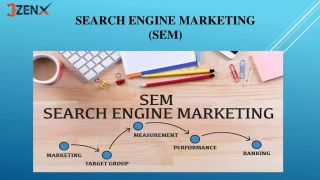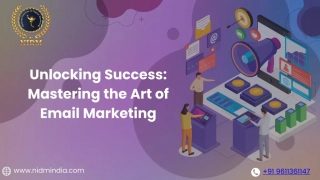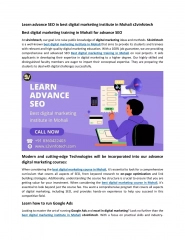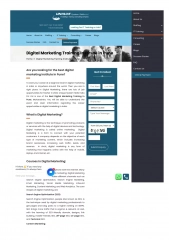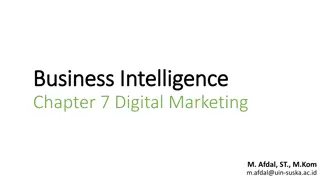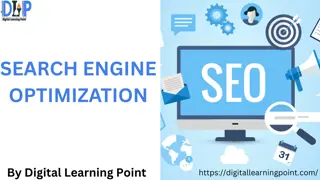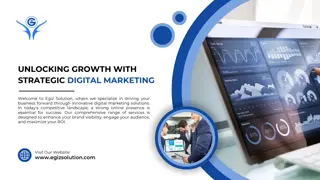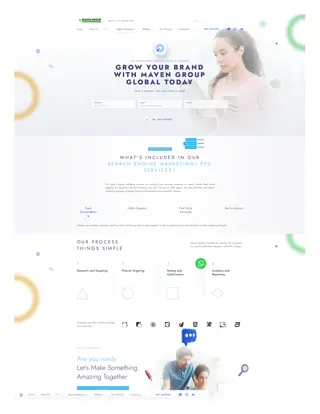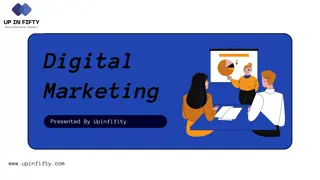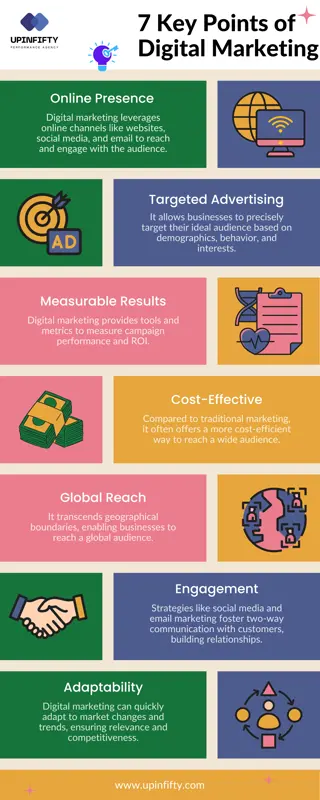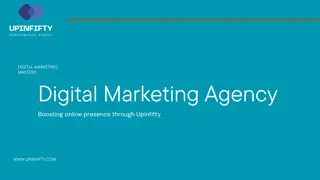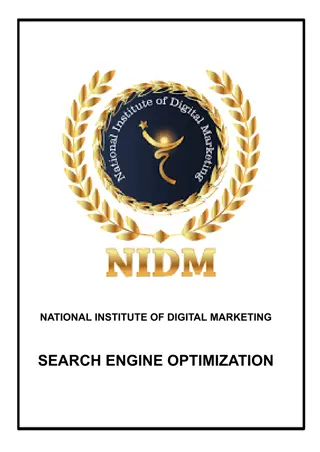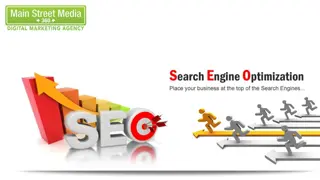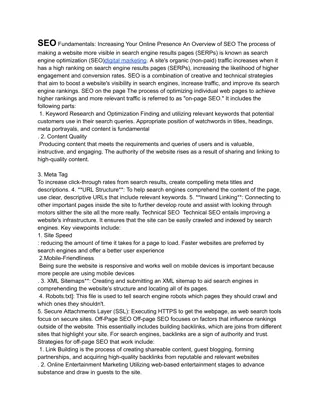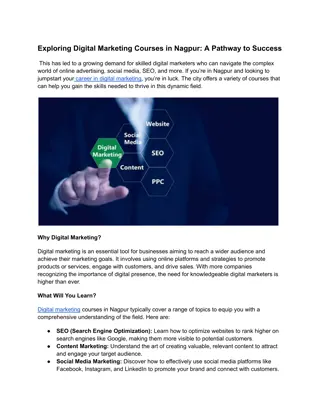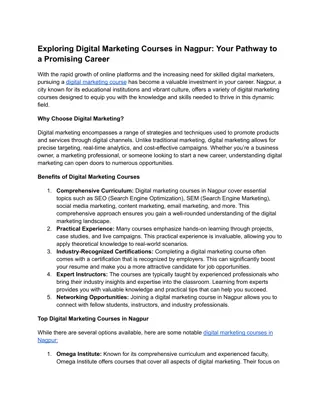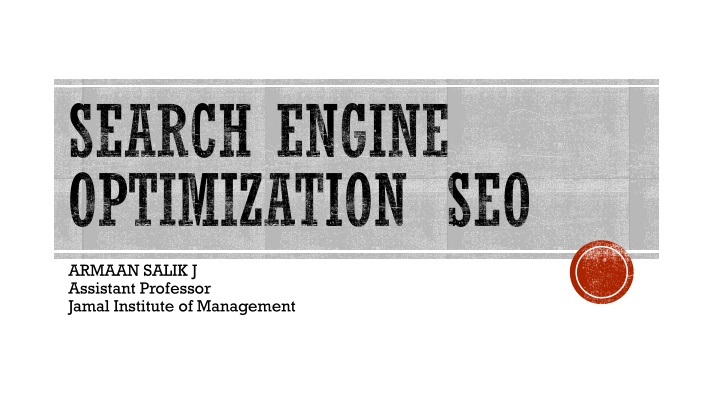
Effective Strategies for Optimizing Website Visibility and Ranking
Enhance your online presence with Search Engine Optimization (SEO) strategies to drive organic traffic, improve credibility, and boost user experience. Explore the key components, benefits, and importance of SEO for long-term success in digital marketing.
Download Presentation

Please find below an Image/Link to download the presentation.
The content on the website is provided AS IS for your information and personal use only. It may not be sold, licensed, or shared on other websites without obtaining consent from the author. If you encounter any issues during the download, it is possible that the publisher has removed the file from their server.
You are allowed to download the files provided on this website for personal or commercial use, subject to the condition that they are used lawfully. All files are the property of their respective owners.
The content on the website is provided AS IS for your information and personal use only. It may not be sold, licensed, or shared on other websites without obtaining consent from the author.
E N D
Presentation Transcript
SEARCH ENGINE OPTIMIZATION SEO ARMAAN SALIK J Assistant Professor Jamal Institute of Management
Search Engine Optimization (SEO): The practice of optimizing a website to improve its visibility and ranking on search engine results pages (SERPs). SEO encompasses both technical and creative elements required to improve rankings, drive traffic, and increase awareness in search engines.
IMPORTANCE OF SEO FOR ONLINE VISIBILITY Increased Traffic: Higher rankings in SERPs lead to increased organic traffic to your website. Cost-Effective Marketing: SEO is more cost-effective compared to paid advertising and offers long-term benefits. Credibility and Trust: High-ranking websites are perceived as more credible and trustworthy by users. Better User Experience: SEO involves improving the usability and user experience of a website, which can lead to higher engagement and conversions.
HOW SEARCH ENGINES WORK! Crawling: Search engines use bots (or spiders) to crawl websites, discovering new and updated pages to index. Indexing: Once a page is crawled, the search engine processes the content and stores it in a massive database called an index. This index is used to quickly retrieve relevant results for user queries. Ranking: Search engines use complex algorithms to rank pages in the index based on relevance and quality signals. Key factors influencing ranking include content quality, keyword usage, site structure, backlinks, and user experience. Serving Results: When a user performs a search, the search engine retrieves the most relevant pages from its index and displays them in the SERPs, ranked by relevance and authority.
KEY COMPONENTS OF SEO On-Page SEO: Optimization of individual web pages to rank higher and earn more relevant traffic. This includes optimizing title tags, meta descriptions, headers, and content. Off-Page SEO: Activities performed outside the website to improve its rankings. This includes building backlinks, social media engagement, and influencer outreach. Technical SEO: Ensuring that a website meets the technical requirements of modern search engines. This includes optimizing site speed, mobile-friendliness, site architecture, and secure connections (HTTPS).
BENEFITS OF SEO Long-Term Strategy: Unlike paid advertising, the effects of SEO can last for a long time and continue to drive traffic even after initial optimization efforts. Higher ROI: SEO can provide a higher return on investment compared to traditional marketing methods. Competitive Advantage: Effective SEO can help you stay ahead of competitors by capturing more organic search traffic. Brand Awareness: High rankings can improve brand awareness and visibility, helping potential customers find and trust your business.
KEYWORD STRATEGY : Importance of Keywords Keywords are the foundation of SEO. They connect what users are searching for with the content you provide to fulfill that search intent. Effective keyword strategy drives targeted traffic to your website, improving visibility and potential conversions. Types of Keywords Short-tail Keywords: Generally one or two words. Broad search intent and high search volume. Examples: "shoes", "laptops". Long-tail Keywords: Three or more words. More specific search intent and lower search volume. Examples: "best running shoes for women", "affordable gaming laptops".
TOOLS FOR KEYWORD RESEARCH Google Keyword Planner: Provides search volume and forecasts for keywords. Useful for finding new keyword ideas. SEMrush: Offers competitive analysis and keyword tracking. Helps identify high-performing keywords used by competitors. Ahrefs: Comprehensive tool for keyword research, backlink analysis, and content exploration. Provides keyword difficulty scores and click-through rates.
HOW TO CHOOSE THE RIGHT KEYWORDS Relevance: Ensure keywords are relevant to your content and target audience. Align keywords with user intent to provide value and answer queries. Search Volume: Target keywords with sufficient search volume to drive traffic. Balance between high-volume keywords (competitive) and low-volume keywords (specific but less competitive). Competition: Assess the level of competition for each keyword. Use a mix of high-competition and low-competition keywords to optimize your chances of ranking. User Intent: Understand the purpose behind user searches (informational, navigational, transactional). Tailor your content to meet different types of user intent.
KEYWORD STRATEGY DEVELOPMENT Identify Your Target Audience: Understand who your potential customers are. Determine their needs, preferences, and search behavior. Create a Keyword List: Compile a list of primary and secondary keywords. Include variations and synonyms to cover different search queries. Group Keywords: Organize keywords into thematic clusters. Plan content around these clusters to improve relevance and SEO performance.
OPTIMIZING CONTENT WITH KEYWORDS On-page SEO: Integrate keywords naturally into titles, meta descriptions, headers, and body text. Ensure content is valuable and engaging to keep users on the page. Content Creation: Develop high-quality content around targeted keywords. Use long-tail keywords to answer specific questions and capture niche traffic.
KEYWORD RESEARCH PROCESS 1. Identifying Your Target Audience Understanding Demographics: Determine the age, gender, location, and interests of your target audience. Behavioral Insights: Analyze the online behavior, preferences, and pain points of your audience. Persona Development: Create detailed buyer personas to better understand and target your audience. 2. Understanding User Intent Types of User Intent: Differentiate between informational, navigational, transactional, and commercial investigation intents. Mapping Intent to Keywords: Align your keywords with the intent of your audience. For example, "buy running shoes" indicates transactional intent. Content Strategy: Develop content that matches the user's intent, providing relevant and valuable information.
KEYWORD RESEARCH PROCESS 3. Analyzing Competitor Keywords Competitor Identification: Identify your main competitors in the industry. Keyword Analysis Tools: Use tools like SEMrush, Ahrefs, or Moz to analyze the keywords your competitors are ranking for. Gap Analysis: Identify keyword gaps where your competitors are ranking but you are not, and vice versa. 4. Creating a Keyword List Seed Keywords: Start with broad, basic keywords related to your business. Long-Tail Keywords: Expand your list with long-tail keywords that are more specific and have less competition. Keyword Grouping: Organize your keywords into groups based on topics or themes for better content planning. Prioritization: Rank your keywords based on search volume, competition, and relevance to your business.
KEYWORD RESEARCH PROCESS 5. Using Keyword Research Tools Google Keyword Planner: Free tool to find keyword ideas and get search volume data. SEMrush: Comprehensive tool for competitor analysis and keyword research. Ahrefs: Excellent for backlink analysis and finding keyword opportunities. Ubersuggest: Free tool for keyword ideas and competitive analysis. 6. Refining and Updating Your Keywords Performance Tracking: Regularly track the performance of your keywords in terms of rankings and traffic. Seasonal Trends: Adjust your keyword strategy based on seasonal trends and changes in user behavior. Continuous Optimization: Continuously refine and update your keyword list to adapt to the changing search landscape.
IMPLEMENTING KEYWORDS On-page SEO: Title Tags: The title tag is a critical on-page SEO element that helps search engines understand the content of a page. It should be unique, descriptive, and include the primary keyword. Example: "SEO Best Practices: How to Optimize Your Website" Meta Descriptions: These are brief summaries of the webpage content that appear in search engine results. Including keywords in meta descriptions can improve click- through rates. Example: "Learn the top SEO best practices to optimize your website and improve your search engine rankings." Headers (H1, H2, H3, etc.): Using headers not only makes the content more readable but also helps search engines understand the structure and main topics of your content. The primary keyword should appear in the H1 tag, and related keywords can be used in H2 and H3 tags. Example: H1: "Ultimate Guide to SEO" H2: "Importance of Keyword Research" H3: "Using Long-tail Keywords"
IMPLEMENTING KEYWORDS Off-page SEO: Backlinks and Anchor Text Backlinks: These are links from other websites to your site. High-quality backlinks from reputable sites can significantly boost your site's authority and search rankings. Example: A blog post on a well-known marketing site linking to your article on SEO strategies. Anchor Text: This is the clickable text in a hyperlink. Using descriptive anchor text that includes relevant keywords helps search engines understand the context of the linked page. Example: "For more detailed information, check out our comprehensive SEO guide."
IMPLEMENTING KEYWORDS Keyword Density and Placement Keyword Density: This refers to the percentage of times a keyword appears on a page compared to the total word count. Maintaining a natural keyword density is crucial; keyword stuffing can lead to penalties. Best practice: Aim for a keyword density of around 1-2%. Placement: Strategic placement of keywords in the title, headers, first paragraph, and throughout the content ensures relevance without overloading the text. Example: "SEO strategies are essential for improving your website's visibility. This guide will cover various SEO techniques, including keyword optimization, to help you rank higher in search results."
IMPLEMENTING KEYWORDS Avoiding Keyword Stuffing Keyword stuffing involves overloading a webpage with keywords in an attempt to manipulate search rankings. This practice is frowned upon by search engines and can lead to penalties. Example of keyword stuffing: "SEO SEO SEO strategies strategies strategies are are are essential essential essential for for for improving improving improving your your your website's website's website's visibility visibility visibility." Best Practices: Use keywords naturally within the content. Focus on providing valuable, readable, and user-friendly content rather than forcing keywords into the text. Example: "SEO strategies are crucial for improving your website's visibility. By implementing these techniques, you can achieve higher search rankings and attract more visitors."
SEO STRATEGY An SEO strategy is a comprehensive plan designed to improve a website s search engine rankings, increase organic traffic, and achieve long-term online success. Importance: Enhances visibility and credibility. Drives targeted traffic to your website. Supports business goals by increasing conversions and revenue.
ELEMENTS OF A SUCCESSFUL SEO STRATEGY On-page SEO: Content Optimization: Creating high-quality, relevant, and engaging content that targets specific keywords. HTML Elements: Optimizing title tags, meta descriptions, headers (H1, H2, etc.), and image alt texts. URL Structure: Ensuring URLs are clean, descriptive, and include relevant keywords. Internal Linking: Linking to other pages within your site to enhance navigation and distribute page authority.
ELEMENTS OF A SUCCESSFUL SEO STRATEGY Off-page SEO: Backlink Building: Acquiring high-quality backlinks from reputable sites to increase domain authority. Social Media Engagement: Leveraging social media platforms to share content and engage with your audience. Guest Blogging: Writing articles for other websites to gain exposure and backlinks. Influencer Outreach: Partnering with influencers to promote your content and brand
ELEMENTS OF A SUCCESSFUL SEO STRATEGY Technical SEO: Site Speed: Optimizing site performance to ensure fast loading times. Mobile-Friendliness: Ensuring your website is responsive and works well on all devices. Secure Sockets Layer (SSL): Implementing HTTPS to secure data transmission. XML Sitemaps and Robots.txt: Using these tools to guide search engines in crawling and indexing your site effectively. Canonical Tags: Avoiding duplicate content issues by using canonical tags.
SETTING SEO GOALS AND OBJECTIVES SMART Goals: Setting Specific, Measurable, Achievable, Relevant, and Time- bound goals. Example: Increase organic traffic by 20% in the next six months. KPIs (Key Performance Indicators): Defining metrics to track progress towards your goals. Examples: Organic search traffic, keyword rankings, bounce rate, conversion rate. Regular Monitoring and Adjustment: Continuously analyzing performance data and making necessary adjustments to strategies.
IMPLEMENTATION PLAN Keyword Research and Analysis: Identifying target keywords and integrating them into your content. Content Creation and Optimization: Developing and optimizing content that aligns with user intent. Technical Audits: Regularly conducting technical audits to identify and fix issues. Link Building Campaigns: Strategically planning and executing campaigns to acquire high-quality backlinks. Performance Tracking: Using tools like Google Analytics, Google Search Console, and other SEO software to monitor progress and adjust strategies accordingly.
ON-PAGE SEO Optimizing Content for Keywords Keyword Placement: Ensure primary keywords are included in strategic places such as the title, headers (H1, H2, etc.), the first 100 words of the content, and the conclusion. Keyword Density: Maintain a natural keyword density, avoiding keyword stuffing. Aim for a balance where keywords appear naturally within the content. Semantic Keywords: Use synonyms and related terms to enhance content relevance without overusing primary keywords.
IMPORTANCE OF HIGH-QUALITY CONTENT Content Depth: Create comprehensive content that thoroughly covers the topic, providing valuable information to users. Originality: Ensure all content is original and not duplicated from other sources. Unique content ranks better and avoids penalties. Engagement: Write engaging content that keeps users on the page longer. Use visuals, bullet points, and other formatting tools to enhance readability.
INTERNAL LINKING STRATEGIES Contextual Links: Link to other relevant pages within your website to provide additional value and context to users. Anchor Text: Use descriptive anchor text for internal links to indicate the content of the linked page. Site Structure: Maintain a logical site structure with a clear hierarchy, making it easier for search engines to crawl and index your site.
IMAGE OPTIMIZATION AND ALT TEXT File Names: Use descriptive, keyword-rich file names for images before uploading them to your site. Alt Text: Provide descriptive alt text for each image, including relevant keywords. This helps search engines understand the content of the images and improves accessibility. Image Compression: Compress images to reduce file size and improve page load times without compromising quality.
META TAGS OPTIMIZATION Title Tags: Craft unique and compelling title tags for each page, incorporating primary keywords and staying within 50- 60 characters. Meta Descriptions: Write informative and engaging meta descriptions for each page, including relevant keywords and keeping within 150-160 characters. Header Tags: Use header tags (H1, H2, H3) to structure content logically, making it easier for search engines and users to understand the main points.
URL Structure Clean URLs: Create clean, readable URLs that include relevant keywords and avoid unnecessary characters or parameters. Consistent Format: Maintain a consistent URL format throughout your site for better organization and navigation. Mobile Optimization Responsive Design: Ensure your website is mobile-friendly and adapts to different screen sizes and devices. Page Speed: Optimize page load times on mobile devices by minimizing file sizes, using efficient coding practices, and leveraging browser caching. User Experience (UX) Navigation: Design intuitive and user-friendly navigation to help users find information quickly and easily. Readability: Use clear fonts, adequate spacing, and contrasting colors to enhance readability. Engagement: Include interactive elements like videos, infographics, and interactive forms to increase user engagement.
OFF-PAGE SEO Building High-Quality Backlinks Backlinks are links from other websites that point to your site. Importance: They are crucial for improving search engine rankings as they are considered votes of confidence. Strategies: Guest blogging on reputable sites. Creating valuable content that others want to link to. Reaching out to industry influencers and bloggers.
OFF-PAGE SEO Social Media Signals Activities on social media platforms that indicate engagement with your content. Importance: While not direct ranking factors, they increase visibility and can lead to more backlinks. Strategies: Actively sharing content on social media. Engaging with your audience through comments, likes, and shares. Building a strong social media presence to drive traffic.
OFF-PAGE SEO Guest Blogging Writing and publishing articles on other websites. Importance: Helps in building authority, driving traffic, and acquiring backlinks. Strategies: Identifying relevant blogs in your industry. Pitching unique and valuable content ideas to blog owners. Ensuring your guest posts include links back to your site.
OFF-PAGE SEO Influencer Outreach Partnering with influencers to promote your content. Importance: Influencers have large, engaged audiences that can amplify your reach. Strategies: Identifying influencers relevant to your niche. Building relationships with them through social media and email. Collaborating on content that includes backlinks to your site.
OFF-PAGE SEO Social Bookmarking Submitting your content to social bookmarking sites like Reddit, StumbleUpon, and Digg. Importance: These sites can drive traffic and increase the chances of earning backlinks. Strategies: Regularly submitting your best content. Engaging with the community on these platforms. Sharing content from others to build reciprocity.
OFF-PAGE SEO Forum and Community Participation Engaging in online forums and communities relevant to your industry. Importance: Helps build your brand's authority and drive traffic. Strategies: Providing valuable insights and answers to questions. Including links to your content when relevant and helpful. Being an active, respected member of the community.
OFF-PAGE SEO Content Marketing Creating and sharing valuable content to attract and retain an audience. Importance: High-quality content can attract natural backlinks and social shares. Strategies: Developing a content calendar. Creating various types of content such as blogs, videos, infographics, and podcasts. Promoting content through various channels to reach a wider audience.
OFF-PAGE SEO Local SEO and Citations Optimizing your online presence for local searches. Importance: Essential for businesses targeting a local audience. Strategies: Ensuring NAP (Name, Address, Phone Number) consistency across all local directories. Encouraging customer reviews on platforms like Google My Business and Yelp. Participating in local community events and online forums.
TECHNICAL SEO Site Speed and Performance Importance of Site Speed: Faster websites provide better user experiences and can improve search rankings. Tools to Measure Speed: Google PageSpeed Insights, GTmetrix, WebPageTest. Techniques to Improve Speed: Minimize HTTP requests, enable compression (e.g., GZIP), optimize images, leverage browser caching, reduce server response time. Mobile-Friendliness Mobile-First Indexing: Google's approach to ranking pages based on the mobile version of the content. Responsive Design: Ensuring your site looks and functions well on all devices. Mobile Usability Testing: Using Google s Mobile-Friendly Test tool to identify and fix issues
TECHNICAL SEO Secure Sockets Layer (SSL) Importance of SSL: Encrypts data between the user and the server, boosting security and trust. SEO Benefits: Google gives preference to HTTPS sites over HTTP. Implementation: Obtain and install an SSL certificate, redirect HTTP to HTTPS. XML Sitemaps Purpose of XML Sitemaps: Helps search engines understand the structure of your site and find all your pages. Best Practices: Ensure your sitemap is up-to-date, includes only important URLs, and is submitted to Google Search Console.
TECHNICAL SEO Robots.txt Function of Robots.txt: Instructs search engine crawlers which pages or sections of your site should not be crawled. Best Practices: Properly configure the robots.txt file to avoid blocking important pages, regularly test and update it using tools like Google Search Console. Structured Data and Schema Markup Purpose: Provides additional information to search engines to improve understanding of your content. Benefits: Can enhance search results with rich snippets (e.g., reviews, ratings, FAQs). Implementation: Use tools like Google s Structured Data Markup Helper, test with Google s Structured Data Testing Tool.
TECHNICAL SEO Canonical Tags Purpose: Prevents duplicate content issues by specifying the "canonical" or preferred version of a webpage. Implementation: Properly add canonical tags to pages that have similar or duplicate content to ensure the correct page is indexed. URL Structure Best Practices: Use clear, descriptive, and keyword-rich URLs. Avoid using unnecessary parameters and keep URLs as short as possible. Consistency: Maintain a consistent URL structure across your site.
TECHNICAL SEO 404 Error Pages Purpose: Provide a user-friendly error page when a page cannot be found. Best Practices: Customize 404 pages to include helpful links and a search bar to improve user experience and reduce bounce rates. Site Architecture Importance: Ensures that your website is easy to navigate and crawl. Best Practices: Use a logical hierarchy, ensure important pages are not too deep within the site, and use breadcrumb navigation.

